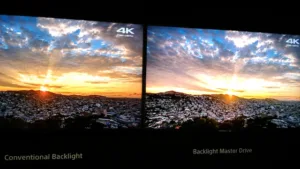One of the highlights of the Sony CEDIA booth were the ZD9 series of HDR TVs. These were being shown in 100”, 75” and 65” screen sizes and attracted a lot of on-lookers with bulging eyes.
We covered these TVs extensively in our IFA report (Sony Highlights Backlight Master Technology at IFA), but there was one interesting tidbit to add. Independent measurements of the peak luminance of these displays suggest they are reaching 1800 cd/m², although Sony does not publicize that number. And while the color gamut is not thought to be 100% of P3, the added brightness of the display makes these colors ‘pop’, creating a clear HDR effect.
As with the new 675ES projector, Sony has a way to adjust the overall brightness level when playing HDR content. This is essentially a control that lifts the luminance of the midtones, thus raising the overall brightness of the image.
One part of the booth compared a conventional direct backlight TV to the new Backlight Master Drive technology in the ZD9 TVs. This featured both HDR content and SDR content upconverted to HDR by the two Sony TVs. The difference was apparent for both types of content.
Sony also was showing the new Z9D TV next to a Samsung KS9500 LCD TV and an LG G6 Signature OLED TV in a ballroom at the Omni hotel. The Sony RGB OLED-based X300 professional monitor with a peak luminance of 1000 cd/m² was placed below the three sets to serve as a reference image.
Sony featured content we had mostly seen before that highlighted some of the benefits of the Sony TV. In particular, a neon sign that is yellow went to white on the Samsung and LG TVs as the brightness (contrast) was raised, but remained yellow on the Sony. This was designed to show the benefits of color volume meaning the ability to continue to show the correct color as luminance levels increase.
The images also revealed some of the loss of dark area details on the G6 and to some degree, on the KS9500 as well.
A pattern of concentric squares with different luminance levels was also used to show how each TV was tone mapping incoming content to fit the luminance performance of the TV. Naturally, the Sony TV was able to provide gray scales differences to nearly 1800 cd/m² whereas the Samsung tone mapped to a peak of 1000 cd/m² and the G6 to a peak of 600 cd/m². This means more highlight details will be visible with the Sony TV. – CC

